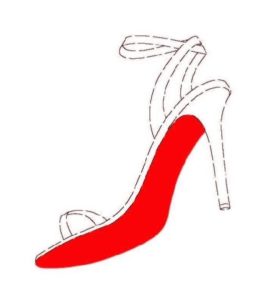28/02/2018
Back in December 2009, Louboutin filed an EU trade mark application (No. 008845539) based on Benelux Trade Mark No. 0874489, for the below trade mark which consists of a red coloured sole (Pantone 18 1663TP) on a high heeled shoe. This application covered goods in class 25 namely “footwear (other than orthopedic footwear)”. This application was registered on 6 January 2010. On 10 April 2013 the goods covered under the registration were amended to “high-heeled shoes (other than orthopedic footwear)”.

In 2012, the Dutch shoe retailer, Van Haren, was selling high-heeled shoes with a red sole, in the Netherlands.
Louboutin brought proceedings against Van Haren, in the Netherlands, claiming trade mark infringement. Van Haren brought counter-proceedings against Louboutin alleging that their trade mark registration relied upon (“the contested mark”) was invalid.
These proceedings were referred from the District Court of the Netherlands to the Court of Justice of the European Union (CJEU).
Under EU trade mark law, Article 3 of Directive 2008/95 outlines the grounds for refusal or invalidity of a trade mark under the following:
‘1. The following shall not be registered or if registered shall be liable to be declared invalid:
(b) trade marks which are devoid of any distinctive character;
- e) signs which consist exclusively of:
- i) the shape which results from the nature of the goods themselves;
- ii) the shape of goods which is necessary to obtain a technical result;
- iii) the shape which gives substantial value to the goods;’
Van Haren alleged that the contested mark was “a two-dimensional mark, more specifically the colour red which, when applied to the soles of shoes, conforms to the shape of the shoes and gives them substantial value.” (Para 16 – Case C‑163/16). So, this falls foul of Article 3(1)(e)(iii) above. But is the mark a shape?
The question therefore for the CJEU to address was whether “the notion of ‘shape’ within the meaning of Article 3(1)(e)(iii) of Directive 2008/95 … limited to the three-dimensional properties of the goods, such as their contours, measurements and volume (expressed three-dimensionally), or does it include other (non three-dimensional) properties of the goods, such as their colour?” (Para 18 – Case C‑163/16).
AG Szpunar Opinion – 1st instance
In reviewing that question, AG Szpunar in his first opinion, of 22 June 2017, considered the classification of the contested mark, with a view to determining whether the mark was a shape mark seeking to protect colour or whether it was a colour mark per se. After thorough analysis of case law, AG Szpunar concluded that the contested mark was a mark consisting of a shape seeking to protect the colour and this could potentially fall within the exclusion of Article 3(1)(e).
Following this opinion, a somewhat unusual situation then occurred. Rather than the CJEU issuing a judgment after receiving AG Szpunar’s opinion, the CJEU allowed the parties to present further oral evidence and referred back to the AG for a further opinion. This appears to be driven by recent changes in the law allowing for “position marks”, and the rewording of the “adds substantial value” exclusion to cover not only shapes but also “another characteristic [of the goods]”. Does this make a difference?
AG Szpunar New Opinion – 2nd instance
AG Szpunar in his latest opinion, of 6 February 2018, said he was even less inclined to classify the mark as a colour mark per se; it had to be the combination of the shape and colour. Looking at this mark, there is no legal consequence, he said, to it being classified as a “position mark”.
He concluded that marks consisting of both a shape and a colour element in relation to the shape are capable of falling within the exclusion of Article 3(1)(e)(iii).
He indicates that his opinion looked only at the intrinsic value of the shape and colour combination. He took no account of any established reputation of the mark or its proprietor. He is answering the question referred to him by the Dutch Court. However, he did seem to indicate that he got the impression that the referring Court was minded to find the mark invalid on this ground.
Louboutin have commented on reports that suggest this opinion is a set back for them. “… A close reading of the full opinion of M. Szpunar in fact supports trademark protection for our famous red sole, rather than threatening it,” Louboutin wrote. “In his opinion, Advocate General Szpunar states that ‘The concept of a shape which ‘gives substantial value’ to the goods, relates only to the intrinsic value of the shape, and does not permit the reputation of the mark or its proprietor to be taken into account.’” The statement continues: “Applying Mr. Szpunar’s opinion to our case supports the validity of our trademark since the shape of the outsole to which the red color is applied is not intrinsically valuable. As for the Christian Louboutin’s red color, the only reason it has value is because of our marketing efforts as well as the public’s association of such color applied to a women’s heeled shoe outsole with Christian Louboutin. As such we are of the view that the opinion of M. Szpunar in fact supports the conclusion, even if it is in favor of the application of criteria for shape mark to our trademark (which we do not agree as we consider our mark to be a ‘position’ mark under EU law), that our mark is valid.”
This discussion of the reputation is interesting because whilst the EU Regulation allows certain marks to escape the bar on registration because the mark has become distinctive through use, it is not possible to escape the bar on registration of shapes which add substantial value to the goods on the basis of distinctiveness through use, as this provision is not listed in the relevant section of the EU Regulation. This is why Louboutin do not want the mark to be considered as a shape and colour combination.
We will report further as this develops.
This article is for general information only. Its content is not a statement of the law on any subject and does not constitute advice. Please contact Reddie & Grose LLP for advice before taking any action in reliance on it.

